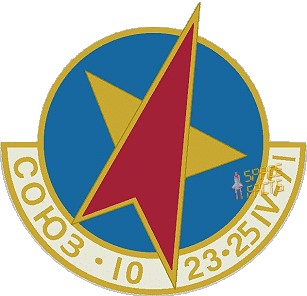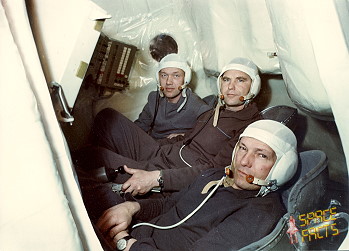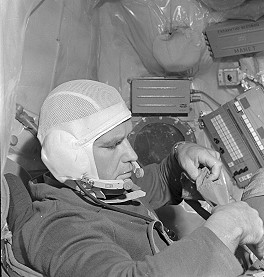Human Orbital Spaceflights
![]()
International Flight No. 39Soyuz 10GranitUSSR |
 |
![]()
Launch, orbit and landing data
walkout photo |
 |
|||||||||||||||||||
alternative crew photo |
alternative crew photo |
|||||||||||||||||||
alternative crew photo |
alternative crew photo |
|||||||||||||||||||
alternative crew photo |
alternative crew photo |
|||||||||||||||||||
Crew
| No. | Surname | Given names | Position | Flight No. | Duration | Orbits | |
| 1 | Shatalov | Vladimir Aleksandrovich | Commander | 3 | 1d 23h 45m 54s | 32 | |
| 2 | Yeliseyev | Aleksei Stanislavovich | Flight Engineer | 3 | 1d 23h 45m 54s | 32 | |
| 3 | Rukavishnikov | Nikolai Nikolayevich | Test Engineer | 1 | 1d 23h 45m 54s | 32 |
Crew seating arrangement
|
 |
|
||||||||||||||||
1st Backup Crew
|
 |
||||||||||||||||||||
alternative crew photo |
2nd Backup Crew
|
 |
||||||||||||||||||||
 |
|||||||||||||||||||||
Hardware
| Launch vehicle: | Soyuz (No. Kh15000-25) |
| Spacecraft: | Soyuz 10 (7K-T No. 31) |
Flight
|
Launch from the Baikonur Cosmodrome and
landing 120 km northwest of Karaganda. The first manned space station was launched on April 19, 1971. Salyut 1 included a number of military experiments, including the OD-4 optical visual ranger, the Orion ultraviolet instrument for characterizing rocket plumes, and the highly classified Svinets radiometer. Primary objectives included photography of the earth, spectrographs of the earth's horizon, experiments with intense gamma rays, and studying manual methods for station orientation. Soyuz 10 approached to 180 m from Salyut 1 automatically. It was hand docked after failure of the automatic system, but hard docking could not be achieved because of the angle of approach. Flight analysis indicated that the cosmonauts had no instrument to provide the angle and range rate data necessary for a successful manual docking. Soyuz 10 was connected to the station for 5 hours and 30 minutes. Despite the lack of hard dock, it is said that the crew were unable to enter the station due to a faulty hatch on their own spacecraft. When Vladimir Shatalov tried to undock from the Salyut, the jammed hatch impeded the docking mechanism, preventing undocking. After several attempts he was able to undock and land. Only a night landing on Soviet territory was possible, which meant the spacecraft could not be oriented for retrofire. The landing commission started planning for an emergency landing in South America, Africa, or Australia. But Vladimir Shatalov reported the gyroscopes and orientation sensors were functioning well. He proposed that he orient on the dayside, spin up the gyro platform, and let the gyros orient the spacecraft on the night side for retrofire. The plan was followed and the spacecraft was targeted for a landing area 80-100 km southwest of Karaganda. So, it was the first night landing in the history of human spaceflights. The Soyuz spacecraft is composed of three elements attached end-to-end - the Orbital Module, the Descent Module and the Instrumentation/Propulsion Module. The crew occupied the central element, the Descent Module. The other two modules are jettisoned prior to re-entry. They burn up in the atmosphere, so only the Descent Module returned to Earth. The deorbit burn lasted 188 seconds. Having shed two-thirds of its mass, the Soyuz reached Entry Interface - a point 400,000 feet (121.9 kilometers) above the Earth, where friction due to the thickening atmosphere began to heat its outer surfaces. With only 23 minutes left before it lands on the grassy plains of central Asia, attention in the module turned to slowing its rate of descent. Eight minutes later, the spacecraft was streaking through the sky at a rate of 755 feet (230 meters) per second. Before it touched down, its speed slowed to only 5 feet (1.5 meter) per second, and it lands at an even lower speed than that. Several onboard features ensure that the vehicle and crew land safely and in relative comfort. Four parachutes, deployed 15 minutes before landing, dramatically slowed the vehicle's rate of descent. Two pilot parachutes were the first to be released, and a drogue chute attached to the second one followed immediately after. The drogue, measuring 24 square meters (258 square feet) in area, slowed the rate of descent from 755 feet (230 meters) per second to 262 feet (80 meters) per second. The main parachute was the last to emerge. It is the largest chute, with a surface area of 10,764 square feet (1,000 square meters). Its harnesses shifted the vehicle's attitude to a 30-degree angle relative to the ground, dissipating heat, and then shifted it again to a straight vertical descent prior to landing. The main chute slowed the Soyuz to a descent rate of only 24 feet (7.3 meters) per second, which is still too fast for a comfortable landing. One second before touchdown, two sets of three small engines on the bottom of the vehicle fired, slowing the vehicle to soften the landing. During the landing, the Soyuz air supply became toxic, and Nikolai Rukavishnikov (much like the case of Vance Brand during the Apollo ASTP return) was overcome and became unconscious. |
Photos / Graphics
 |
 |
 |
 |
 |
 |
 |
 |
 |
| © |  |
Last update on May 11, 2021.  |
 |